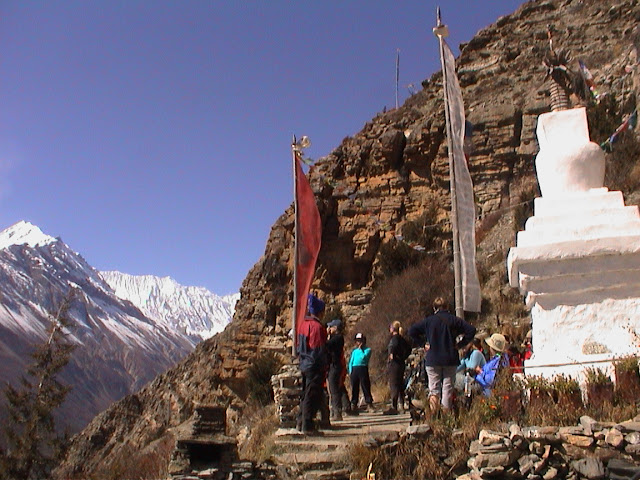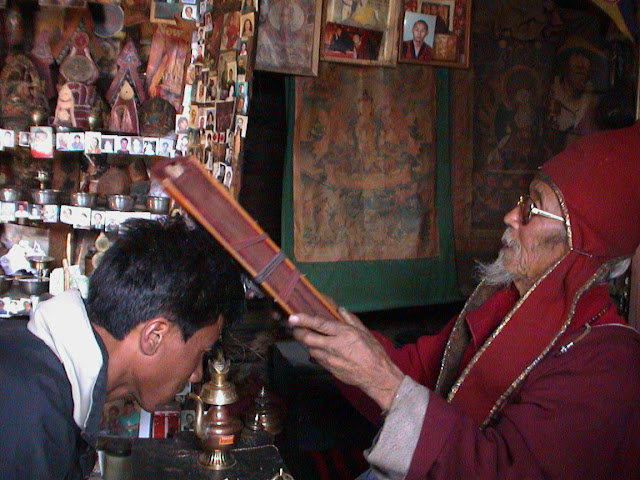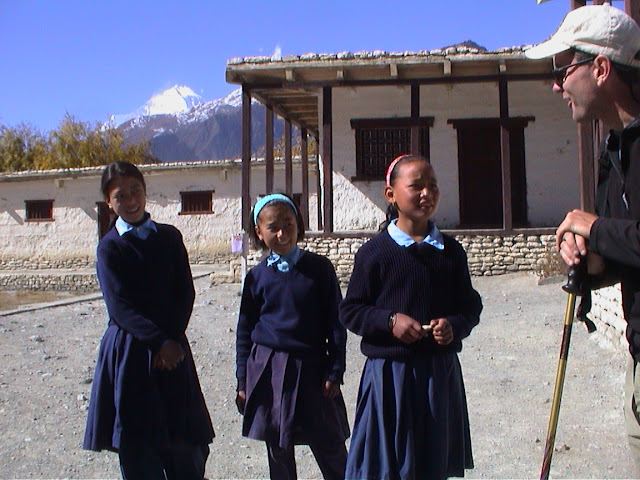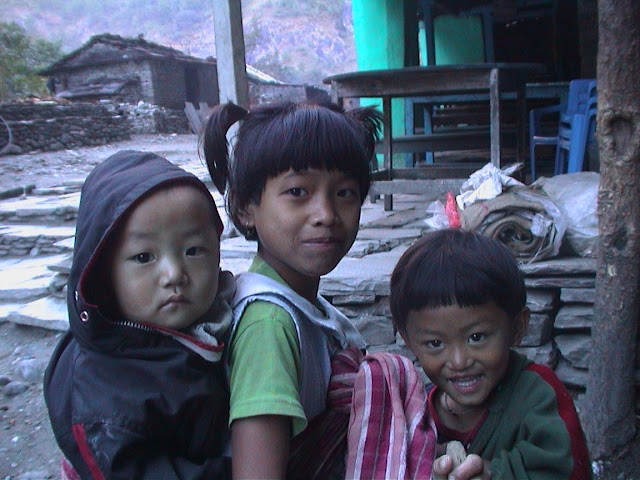This trip combined the beauty of the Nepalese Himalayas with the inspiration of seeing Room to Read programs in remote villages along the Annapurna Circuit.
During the fall of 2002, I joined seven other donors and John Wood, the founder of Room to Read, on our Trek for Literacy around the Annapurna Circuit. Each of us had to raise at least $3,000 in donations for Room to Read--www.roomtoread.org--to join the trek, plus pay for our airfare and the trek. I raised the funds by giving travel adventure presentations to senior residences, and community groups.
Even after we had scheduled our flights to Kathmandu, Nepal, we each had a chance to cancel because of the Maoists activities in Nepal that caused the government to enter a state of emergency following the massacre of most of the royal family in 2001 along with mounting deaths of soldiers, villagers, and rebels. We all decided to proceed since we heard that the warring factions proclaimed safe zones for the tourist locations of the Annapurna Circuit and Mt. Everest area. Tourism is their biggest income producer.
Lots of military presence throughout Kathmandu especially after we heard a bomb go off at a nearby bus station.
The recent earthquakes have reduced these century-old buildings to rubble.
We met up at our Hotel Utse in Kathmandu for a few days before heading to Besi Sahar, the starting point of our three-week trek around the Annapurna Circuit.
The Boudhanath Stupa is the largest Buddhist stupa in Kathmandu and a gathering place for Tibetan refugees.
While in Kathmandu, John Wood was interviewed by a reporter from the Nepali Times about the work of Room to Read.
Our plans to meet up with a group of Room to Read girls who were on scholarships in the Kathmandu area were canceled because of a banda--strike--where all public transportation was canceled.
We are ready for adventure on the treacherous roads of Nepal. This would be the most dangerous part of our adventure.
Our trip started by taking in a few sights in Kathmandu before we began our bus ride to some of the Room to Read libraries and built schools, on the way to Besi Sahar.
We stopped at the Simle school which Room to Read had built along with the local community. Each party provided half of the cost of this new school. Government officials attended this opening ceremony. Here John Wood is surrounded by some of the students while he is reading from one of the books we brought with us.
From here, we proceeded to Bairani village, where Room to Read had partnered with the community to remodel and expand the school to meet earthquake standards.
Our final village stop was Beneghat which was kind of an iffy stop because the Maoists had recently bombed the community building that was next to the new school that one of our travelers, Hilary Valentine, had helped fund and had dedicated it to her parents.
Bombed Out Community Center
Hilary stands by the principal and teachers by the dedication plaque.
We meet with the school community committee.
John and Hilary sat on the girls' side of this classroom.
We spent the night in Besi Sahar and saw these curious kids just outside our hotel. We were the main attraction. Tourism was down because of the Maoist activities and the military was ever-present and even boarded and inspected our bus.
This vendor is offering lots of tikka powder choices to the Hindus.
From there we began our 200 km. trek around the Annapurna Circuit at an altitude of 2,700 feet. In this three week trek, we would come to some of the Room to Read sponsored projects, pass by numerous villages only accessible by this trail, climb to the 17,769-foot summit of La Throng Pass, and end up hiking through the Kali Gandaki River Valley, the deepest valley in the world, to Beni for a bus ride to Pokhara and flight back to Kathmandu.
After a night in Besi Sahar with a dusk to dawn curfew because of Maoist activity, we began our trek and arrived in Ngadi after a hike of only four hours.


At the beginning of the trek, we met our guides and porters that John Wood had hired from the 3 Sisters Trekking Company. Among the porters were two women who were training to be guides so that future women travelers would find it more comfortable traveling with these women guides.
These are the two women porters who are learning to become guides. The first is Batuli and the second is Nirma as they approach Bahundanda village. It seemed like they were carrying their weight in those bags.
We stopped here for some tea in Bahundanda at this covered area where John Wood was first inspired to create Room to Read back in 1998. He was having tea in Besi Sahar when he met a school inspector that encouraged him to visit the nearby school.
It was at this school where the principal told John, "Perhaps, sir, you will someday come back with books." That experience and comment would forever change the direction of John's life and became the catalyst for Room to Read.
Along the way, we visited three of the schools sponsored by Room to Read where we were welcomed by enthusiastic students with clapping, laughter, and garlands of beautiful flowers.
On our first day, we ended up at the Hikers Lodge at Ngadi where we would experience the Festival of Lights known as Dawali as a procession of villagers who visited us with candles and treats. They also danced for us and invited us to join in which we did.
Brett, John, and Marie are finishing up their chai before heading off to the school.
The school was a short walk up the hill. John Wood, the founder of Room to Read, helped this village build the school and dedicated it to his parents.
We were each given garlands of chrysanthemums as we came into the schoolyard along with many greetings of "Namaste"--a greeting that means I bless the god within you--which we returned along with a wai.
The students were enthusiastic and we challenged them to some volleyball and singing games--Old MacDonald Had a Farm and I'm a Teapot--which were popular. They, in turn, played some beautiful Nepali songs accompanied by drums. Near the end of our time, we gave some of the kids our garlands as a token of thanks.
This student got my garland.
On the third day of our trek to Jagat, elevation 4,300 feet, the scenery began to change, and the people are more Tibetan-like with houses now built of stone and vegetation less tropical. We surprised the villagers with our own Halloween party there.
Our sleeping bags came in handy to keep us warm during the ever-increasing cold nights.
Our porters are preparing to haul our bags to the next village. My bag is the blue one with the pink tag. One of the two guides goes ahead to secure a place for us to stay while the other stays to settle up the bill with the innkeeper. The guides involve the two women porters in the negotiations with the innkeepers as a part of their training.
Here I came across some kids who were preparing for school.
On the subsequent days of trekking, we continued up along the Marsyandi River through villages of Dharapani, Tal, and Chame.
We had lunch in Tal surrounded by all of these kids. It was here where I got my trail name of "Hoov"--short for Hoover vacuum cleaner. We were finishing up lunch, and I did my usual and asked others if I could finish up their meals if they were done. At that point, John Wood said I was just like a Hoover vacuum cleaner sucking up all the leftovers. From then on, everybody called me "Hoov", and I adopted that name during my long-distance hike of the Pacific Crest Trail among other long hikes.
We ended up staying at this very picturesque hostel just across the river against this cliff after passing through the Chame village.
The following night, we were in Pisang where Brett and I climbed up to a nearby hilltop for a view of the village below and the mountains around us.
The following morning Hilary and Maria prepared to leave Pisang with the Pisang Wall, a glacial scoured out mountain behind them.
Heading to the next villages of Ghyaru, the elevation of 12,050 feet, John Wood stood before the Annapurna II where we had our first spectacular views of the Annapurna massifs.

We had our lunch on this rooftop restaurant and teahouse while enjoying the expanse of the Annapurnas.



While waiting for our chai to heat, this woman is busy spinning yarn. The kids are curious.


While there we visit the local Llama who gave us his blessings from the Tibetan book of prayers.

On days 8 and 9 of our trek, we stayed in Manang, elevation 11,480 feet, to acclimate to the higher elevations yet to come. While there, we got a briefing from a medical group about the dangers of altitude sickness, dehydration, and hypothermia.
A group of us including some of the guides and porters climbed up to the Hermitage--about 2,000 feet overlooking Manang. We all received blessings from this Buddhist Llama including the guides and porters. Our guides and porters are Hindus, but at this high elevation, they become open to the Buddhist ways and receive blessings as well. Some have brought pictures of themselves to leave with the Llama so that their images can continue to receive blessings.
Behind this woman are hundreds of photos the faithful have left here to receive continued blessings.
Here are the Llama's quarters high above Manang.
I then explored the other side of the Manang valley and saw this beautiful blue lake with prayer flags strung along with the pine trees.
After acclimating to the higher altitudes, we leave Manang behind. Our guide is carrying a portable hyperbaric chamber--to aid in recovering from altitude sickness-- that is inside the blue bag.

The villager we pass is hauling food for her animals.

We stop for lunch and views at Gungsang.

From here to Kagbeni the vegetation became increasingly sparse and it gets colder and harder to breathe at this higher elevation.
We begin to pass numerous herdsmen with their yaks that only thrive at this higher elevation.
We receive a bit of posted trail advice on our way to Phedi and a teahouse for some hot chai.
The Marsyandi River became small enough to jump boulders to cross it on our climb up to Upper Throng Phedi, elevation 15,020.
We had to descend to the bottom of the river valley before climbing up to Upper Throng Phedi.
Angela, Jen, John, Katy, Kristen, Hilary, and Maria are posing before heading down and then back up to Throng Phedi for lunch before continuing on to Upper Throng Phedi for our night stay.
Angela, Jen, John, Katy, Kristen, Hilary, and Maria are posing before heading down and then back up to Throng Phedi for lunch before continuing on to Upper Throng Phedi for our night stay.
Yak meat with rice and vegetables was the specialty here that John, Angela, and Maria are enjoying.
We spent the night in zero degrees weather with a light dusting of snow and frequently woke up during the night gasping for breath at this high altitude.
We left just before dawn for our ascent to the 17,769 foot Throng-La Pass where it was clear, cold--10 degrees F.-- and windy marked by chortens and prayer flags fluttering in the breezes.
This is the first time for these women porter/guides to travel over La Throng Pass. One of the other porters got altitude sickness and had to return to Manang. None of our group suffered from altitude sickness, but one had an injured knee that slowed her down a bit.
My happy dance celebration for reaching the summit.
Celebrating with our two guides---Indra and Indra G.
John Wood is happy to be at the summit as well.
Batuli is at the summit still carrying my bag.
Nirma is pleased to be at the summit as well.
To celebrate arriving at the summit of La Throng Pass, Brett reprised his Halloween costume as "Helmut, Hiker Trash" complete with fangs.
We add our own prayer flags to the others before heading down to Muktinath, Kagbeni, Jomsom, and Marpha.
We stopped for refreshments at the first teahouse on our long and very steep descent to Muktinath.
A discarded doco--Nepali backpack--was left along the trail.
The first village we come to is Muktinath which is one of the most religious pilgrimage sites for both Hindus and Buddhists.
These vendors are selling several religious materials for both Hindus and Buddhists for use at the sacred sites.
The arriving horse caravan announces their arrival by the many bells attached to these decorated horses and mules.
Lots of prayer flags decorate this sacred spot where the elements merge--earth, fire, water, air, and ether--and are in perfect balance here. Inside the building, there is a flame supposedly fueled by methane seeping from the ground. Outside there are 108 bull faces through which water is poured.
We all took the time to rinse our hands in all of these 108 water spouts before heading to Kagbeni for the night.
Here is the Kangbeni village and to the right of it is the Mustang Region which is off-limits to outsiders---unless you pay a lot for a "permit".
Both Kagbeni and Marpha build up walls along the walkways to cut down on the stiff winds that blow dust-up from the Kali Gandaki River Valley. These are prayer wheels often found at the entrances to villages.
Here is the view of the Mustang Region.
While at this school, we met a Peace Corps Volunteer who was doing community service and teaching.

John was consulting with the Kagbeni Room to Read Library Committee.

A fertility statue stands beside the prayer wheels.
Our next village was Jomsom which was a somewhat return to civilization with an airport and internet connections. It was there we visited another Room to Read sponsored school and library. The principal talked to John about building a sunroom so that the children could stay warm on the cold sunny days in the wintertime, especially when they arrived before school started. He wanted it built on the rooftop of some of the classrooms.
We then trekked to Marpha where we had time to visit a nearby Tibetan refugee camp that was across a suspension bridge, do a bit of shopping, and relaxing.
Tibet Community Meeting
Brett is doing a bit of shopping negotiations.
Our porters are relaxing as well as near the end of our trek.
Moonrise over Dhaulagiri peak.
We have now entered the level portion of the Kali Gandaki River Valley and stop for lunch at a teahouse in Ghasa beside a waterfall.
On our last full day on the trail, we ended up at Tatopani and soaked off the dust in the natural hot springs found down by the Kali Ghandaki River and then celebrated the end of the trek with our 3 Sisters Trekking Company porters.
Nigiri Peak is framed by banana leaves at Tatopani.
Our final day of trekking was along a primitive road that led us to Beni where a bus returned us to Pokhara. The bus ride was the most dangerous part of the trek.
Trip cost
The total cost to Japan, Nepal, and Thailand was $3,163, an average daily cost of $85.
The 7 days Japan adventure cost was $632 for a daily average cost of $90.
The 8 day Thailand adventure cost was $481, an average daily cost of $60.
Travel costs for the Nepal portion were 60,000 United Frequent flyer miles, and $350 for a round trip Thai Air flight from Bangkok to Kathmandu. The land cost, including tips, was $1,700 for the 24-day trek or $71 per day.
Subscribe to my YouTube Channel
I have recently uploaded all of my travel videos to YouTube now that they allow longer uploads. I have also added other shorter travel videos.
That link is https://www.youtube.com/c/huntforgold
If you do go there, please subscribe to my video channel since it will help me eventually get some income there and help with my future travels.























































































































